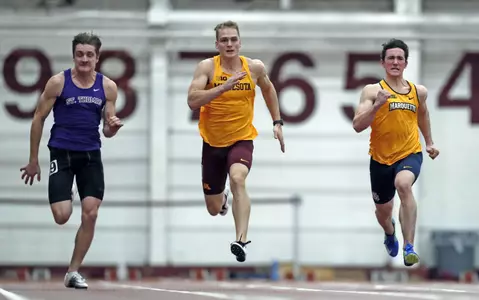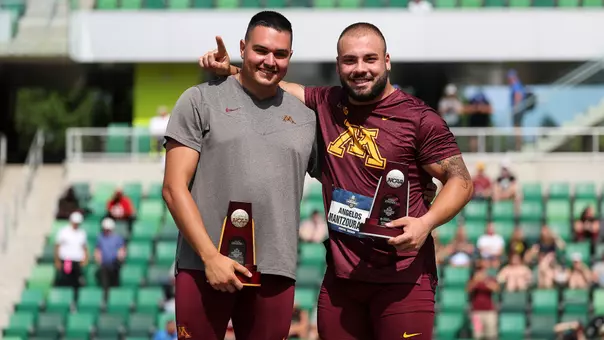University of Minnesota Athletics

Know the Gophers: Teddy Frid
4/26/2018 12:00:00 AM | Men's Track & Field
Content created by Jackson Riebel
MINNEAPOLIS - After earning Second Team All-American honors with a 10th-place finish in the heptathlon at the 2018 NCAA Indoor Track & Field Championships, Gopher junior Teddy Frid has turned his focus to the decathlon in the outdoor track & field season. Last weekend Frid finished ninth overall at the 2018 Bryan Clay Invitational, his first decathlon competition as a Gopher.
A native of South St. Paul, Minnesota, Frid spend two years at the University of Sioux Falls before transferring to Minnesota prior to the 2017-18 academic year. While at Sioux Falls Frid was twice a NCAA Division II All-American and was named the 2017 Northern Sun Intercollegiate Conference Men's Field Athlete of the Year.
Frid is set to compete at National Relay Championships in Fayetteville, Ark. this weekend. The event is hosted by the University of Arkansas and will feature athletes from Minnesota, Arkansas, Baylor, Florida, Florida State, Kansas, Kentucky, Miami, Michigan, Oklahoma State, Stanford, TCU, Tennessee, Texas, Virginia Tech and Wisconsin.
Gophersports.com sat down with Frid this week to talk about his success in his first season in Maroon & Gold.
You recently transferred to the University of Minnesota after spending two years competing for the University of Sioux Falls. What went into the decision to become a Gopher?
It kind of happened abruptly. Things were going great at Sioux Falls, I had no problems with the coaching staff or anything like that. However, I had improved in a bunch of different events, so after some changes to our coaching staff I was encouraged to consider competing at the next level. I sent my release forms out to the top Division II schools in the nation and included the University of Minnesota. I remember telling my dad that I included Minnesota but thought there was no way that they would contact me. But I got an email from my athletic director at Sioux Falls saying that she had sent the release forms out and the process was now up to me. Literally an hour later I was contacted by [Minnesota director of operations] Zach Siegmeier, who told me that I should call Paul Thorton, the associate head coach. I talked to him a bit and then got here for a visit. From that point on the decision to come here was a lot easier after seeing the indoor track and the opportunities to compete at the Big Ten level. I'm also from South St. Paul, so being close to my hometown and family and friends is big.
How have you managed the transition to a new school as a junior?
I thought at first classes would be tougher here, just because I knew the schedule would be busy with the track & field team leaving for weekend competitions on Wednesdays and Thursdays. I was a good student at Sioux Falls and was able to manage school and sports pretty well, but I wasn't sure if I was going to be missing assignments and tests when I transferred here. But so far, it's been pretty easy. Staying on top of your schoolwork, remembering that school comes first, and working ahead all help. I think it also helped that I was a junior, because I had already gone through two years of sports and school and knew what I was getting myself into. To be honest, I haven't felt or seen much of a difference.
You were a multiple sport athlete growing up in South St. Paul. How did you originally get involved with track & field?
I played baseball up until seventh grade, and played hockey and football throughout high school, but track & field never interested me when I was young. It's usually not much of a youth sport, especially in the United States. My sixth-grade teacher was really in to track, and he noticed in gym class that I had some jumping ability and told me to high jump at a middle school track meet. I did pretty well, and he told me to go out for track my seventh-grade year. I ended up jumping very well as a seventh grader and made varsity in eighth grade as a high jumper.
You've had a lot of success in both the heptathlon and decathlon as a collegiate athlete. What does it take to have success when competing in multiple events over a two-day period?
You need to have a very short memory. When you have ten events, a few are not going to go as well as you want them to go, that's just how it is. You can't be your best in every event across a two-day span. You have to be able to accept that an event didn't go the way you wanted it to and not dwell on it and let it affect your performance in the next event. I always try to remember that it's a total of all the events, not just the first four. For example, in the Big Ten Indoor Championships I was in ninth or tenth place after the first day, but I knew that day two is my best day, so I tried to take forget about day one, took the positives from it that I could and ended up winning all three events on day two. It's important to not let your negative performances effect your next events and trust your athleticism to carry you through the events where you're not as strong.
Earlier this spring you became a Second-Team All-American thanks to a 10th place finish in the heptathlon at the NCAA Indoor Track & Field Championships. What did that accomplishment mean to you?
It was pretty mind-boggling, hard to believe. A year ago when I was at Sioux Falls I made it to the NCAA Division II National Championships, and I looked at that as the pinnacle of my career. Never in my mind did I think that becoming a Division I All-American was within reach. It's not that I didn't believe in myself, it was just that with the way things were going I was planning to finish my four years at Sioux Falls. Just to make it to the NCAA Division I Indoor National Championships this year was surreal and hard to believe. I knew once I got [to Minnesota] that I had the ability to make it there, because at Sioux Falls I had scores in each event [of the heptathlon] that were good enough, but it's all about being able to do it on the same day. After I started training and noticed myself getting faster, gaining endurance and raising my vertical, I knew that I had the ability to put it all together.
What are your goals for the rest of the outdoor season?
I'm not as strong in the decathlon as I am in the heptathlon, because the decathlon adds in two throwing events, which aren't my strength. When you switch from the heptathlon to the decathlon a lot of people think that you're the same in both, but it varies a lot. Some guys who didn't do so well in the heptathlon will be doing a lot better in the decathlon because of those two throwing events. But a top-five finish at the Big Ten Championships and making it to Nationals are two goals that I think are within reach if I can set my mind right and have a good couple of days.
Where do you see yourself in ten years?
The end goal is always to still be competing. But I'm a business major, and while I'm not quite sure what I want to do yet I know I want to be on the networking side of things. Whether that means I work in public relations for a company or whatever it is, I really enjoy connecting people, so that's the area I want to go into. I'm also thinking about minoring in coaching and could see myself as a volunteer coach or assistant coach. That's something that really interests me.
Quick Hits:
Who Plays You in a Movie: Ryan Reynolds
Funniest Teammate: Jake Buller
Favorite Movie: I Am Legend
Go-to Restaurant: Applebee's
Pump-up Song: Welcome to Detroit - Eminem
Favorite Hobby: Fishing
Secret Talent: Can solve a Rubik's cube in less than a minute








